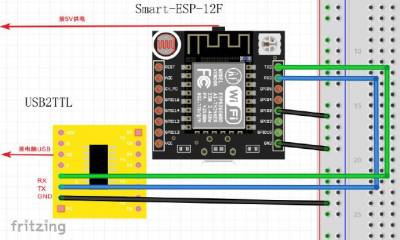Table of Contents
Webduino Smart
Goals
- [OK] Flash Webduino Smart with different IDEs
- [OK] Check Components : pins, photocell, RGB LED, button
- [OK?] Use OTA
Description
- Webduino Smart USB port is only used to power the board, not for upload and monitoring
- The chip is labeled ESP8266MOD by AI Thinker, in fact it is an ESP-12F, same as Wemos D1
- The board includes a photocell, an RGB led and a button.
- Unofficial tutorial in ~english, with how to flash Webduino Smart with FTDI
- The Webduino Smart is extremely similar to the “(Gizwits) Witty Cloud” board, one is probably a clone of the other (same pin number for on-board components). The Witty Cloud board includes an FTDI daughter board which simplifies development, this daughter board may even be compatible with the Webduino Smart.
Wiring and flashing
Plug the Webduino Smart using an FTDI 3.3v module. The Webduino Smart and the FTDI must be powered. The Webduino Smart is powered through its micro USB port.
Tx Rx
ftdi Rx Tx Webduino
Gnd Gnd
For flashing, on Webduino Smart connect GPIO 0 to GND. (RGB goes light blue)
For rebooting, on Webduino Smart connect RST to GND
Flashing usual sequence is:
- Set flash position (GPIO0 on GND)
- Power the FTDI and the Webduino
- (RGB goes light blue) Disconnect GPIO 0
- Upload sketch… Webduino Smart should restart in normal mode.
- Or disconnect GPIO 0 and restart using RST or Webduino Smart power
Arduino IDE
Select Board : “Generic ESP8266 Module”
Platformio
Got it to work as a Wemos d1!
[env:d1] platform = espressif8266 board = d1 framework = arduino
Components
I got blink sketch using LED_BUILTIN (2)
RGB LED
/*** RGB sketch for webduino smart Board: ESP8266 */ #include <Arduino.h> // according to https://webduino.io/en/tutorials/smart-01-information.html#on-board-components-and-pins #define GPIO_GREEN_RGB 12 #define GPIO_BLUE_RGB 13 #define GPIO_RED_RGB 15 #define GPIO_MICRO_SWITCH_BUTTON 4 // https://create.arduino.cc/projecthub/muhammad-aqib/arduino-rgb-led-tutorial-fc003e void RGB_color(int red_light_value, int green_light_value, int blue_light_value) { analogWrite(GPIO_RED_RGB, red_light_value); analogWrite(GPIO_GREEN_RGB, green_light_value); analogWrite(GPIO_BLUE_RGB, blue_light_value); } void showColor(int color) { Serial.printf("Color %d\n", color); switch (color) { case 0: RGB_color(255, 0, 0); // Red break; case 1: RGB_color(0, 255, 0); // Green break; case 2: RGB_color(255, 255, 125); // Raspberry break; case 3: RGB_color(0, 255, 255); // Cyan break; case 4: RGB_color(255, 0, 255); // Magenta break; case 5: RGB_color(255, 255, 0); // Yellow break; case 6: RGB_color(255, 255, 255); // White default: RGB_color(0, 0, 0); // Disabled } } void setup() { Serial.begin(115200); delay(10); Serial.println(); Serial.println(F("Webduino smart RGB sketch: push the micro switch button to loop over colors")); pinMode(GPIO_GREEN_RGB, OUTPUT); pinMode(GPIO_BLUE_RGB, OUTPUT); pinMode(GPIO_RED_RGB, OUTPUT); } int color = 0; void loop() { if (digitalRead(GPIO_MICRO_SWITCH_BUTTON) == LOW) { Serial.println(F("Button pressed")); color = ((color + 1) % 7); showColor(color); delay(200); } }
Photocell
/*** Photocell sketch for webduino smart Board: ESP8266 */ #include <Arduino.h> // according to https://webduino.io/en/tutorials/smart-01-information.html#on-board-components-and-pins #define GPIO_PHOTOCELL A0 #define GPIO_MICRO_SWITCH_BUTTON 4 void setup() { Serial.begin(115200); delay(10); Serial.println(); Serial.println(F("Webduino photocell sketch: push the micro switch button to read photocell values")); } void loop() { if (digitalRead(GPIO_MICRO_SWITCH_BUTTON) == LOW) { Serial.println(analogRead(GPIO_PHOTOCELL)); // values go from 0 for complete darkness to 1024 for full bright light } }
OTA
See https://github.com/esp8266/Arduino/tree/master/libraries/ArduinoOTA/examples
This was randomly working for me, maybe implement this workaround?
